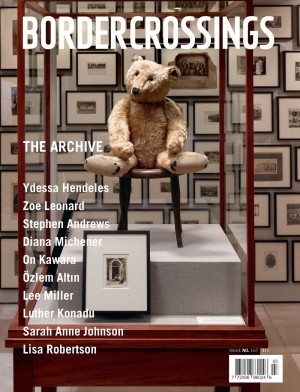Nicholas Baier
There are some dissenting voices when it comes to Nicholas Baier’s exhibition “Hunting Gallery,” for it defies the traditional methodology of showing art and rattles the institutionalized structure that controls how art is presented to the public. The Montreal Museum of Fine Arts, like many museums, groups its artworks by style, medium and technique within homogeneous categories: Ancient Cultures, European Art, Canadian Art, Inuit and Amerindian Art, Contemporary Art and Decorative Arts. Yet Baier challenged this arrangement by inserting his photographic works throughout the different collections. He explains, “What you have to remember is, this exhibition is an accident. It happened only because there was not an available room. In the beginning, they wanted me to hang the works in the hallways and next to the elevators. I said, ‘No way, I want to be in the rooms.’ That is how the idea came about. It happened because we needed to find somewhere to hang the work.”
The lack of available space inadvertently has led to one of the most interesting art presentations of the year. The intermingling of the contemporary with the historical heightened my appreciation not only of Baier’s work, but also of the museum’s permanent collection. Baier’s pieces already existed; they were not created for preconceived spots in the galleries or even specifically for this show. Baier thought the concept of hanging them among the different collections would allow the various curators a “magnificent occasion to amuse themselves,” but it didn’t work. He found their suggestions on where to place the photographs were too intellectual, not enough from the gut. He and the museum’s contemporary art curator Stéphane Aquin walked through the galleries, and, in an hour and a half, instinctively decided how the show would be hung.

Nicholas Baier, Atelier, 2005, installation view, digital ink jet print on photographic papers on photographic paper, mounted on Plexiglas and aluminium, 180 x 122 cm. Photographs courtesy René Blouin Gallery, Montreal.
The viewer, map in hand, is sent out to hunt for Baier’s 17 pieces over the five levels that comprise the museum’s three pavilions. It isn’t as easy a task as you’d imagine. The first room I entered was in the museum’s Contemporary Art section. I scanned the artworks and couldn’t pick out which was Baier’s piece. Cité, at first glance, appears to be a large abstract painting, until you notice the small figures walking in a group at the bottom. In the next room, housing Islamic art, Baier’s large digital print under Plexiglas, titled Monolith, rests directly on the floor. It shows a marble door in a marble wall and a bit of the floor beneath. The worn surfaces, the cracks in the floor and the veining of the marble strike up a rapport with the cracked and worn surfaces of the over 1000-year-old pottery that surrounds it.
The work titled Mirror is a black and white composition depicting scuffed and dirtied concrete walls and a linoleum floor. It intriguingly mirrors the black and white compositions by Paul-Émile Borduas that hang on the facing wall. Without thinking, I found myself swivelling my head back and forth, noting the similarities and differences of the mark making in the works. Baier’s Canada Is in the Bog of a Golf Course in Lava_l is a picture of pond scum, while _Canada Is Painted into the Corner of an Old Penitentiary in Laval is a view of peeling paint. Both images look eerily like maps of Canada. Both are humorously hung among other visions of Canada by Group of Seven artists Lawren Harris, Frank Carmichael and Arthur Lismer. Another piece in the exhibition is called Star. Baier made the image by scanning concrete and dirt, which he makes appear like a tomb floating in the heavens. A dialogue is easily formed between the work and the other pieces in the Mediterranean Archaeology room, a dialogue that continues to grow as the viewer hunts down each successive work.

Nicholas Baier, Monolith, 2005, installation view, digital inkjet prints on photographic paper mounted on Plexiglas and aluminium.
Baier says his approach is very simple; he walks around and looks. But don’t be deceived into thinking the images are the result of an effortless click. His pieces are meticulously built up from many digital images taken with either his camera or scanner. He uses Photoshop software: principally the cut and paste tools, some colour adjustments, never the filters. Baier manipulates and constructs his works as if digital photography were just another medium for painting. He comments, “I am working on a vague project, one that I will probably never complete, in which I touch on every period of painting in my work. I am doing this without consciously doing it.”
So here we have an artist whose exhibition was the result of a happy accident, who unconsciously references the history of painting and who hangs his show by instinct. I applaud this because it is the level on which art operates. When it works, it hits us immediately, rapidly. Afterwards, we can look longer and ask ourselves why and try to express what it was that made the work speak to us in the first place. So the next time you go to the gallery, take Baier’s lead, trust your gut, open your eyes and see. ■
“Nicolas Baier: Hunting Gallery” was exhibited at the Montreal Museum of Fine Arts from March 22 to May 28, 2006.
Christine Redfern is a Montreal-based artist and writer.

